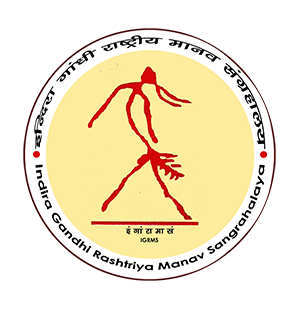वारली आवास
जनजातीय: वारली
क्षेत्र: ठाने, महाराष्ट्र
संकलन वर्ष : 1988
वारली एक जनजाति, जिनकी चित्रकला प्रकृति की गाथा को दर्शाती है।
वारली महराष्ट्र के ठाणे जिले के दहानु, तलसारी, जवाहर, पाल घर और मोखाडा तालुका, नासिक तथा धुले जिले के कुछ भागों में निवासरत तथा गुजरात के वलसाड़ जिले ओर केन्द्र शासित प्रांतों दादर और नगर हवेली तक विस्तृत एक जनजातीय समूह है। वारली शब्द ‘वारूल’ से लिया गया है जिसका अर्थ है भूमि का टुकड़ा। वारली मुख्यतः कृषक है, मछली व मुर्गी पालन उनका द्वितीयक व्यवसाय है।
वारली प्रथाओं और परम्पराओं का ताना-बाना प्रकृति के इर्द-गिर्द बुना है। वे वन्य जीवन और प्रकृति के प्रति असीम आदर दर्शाते हैं। वारली आवास हमेशा ही वर्गाकार और मिट्टी के आधार युक्त होता है। निर्माण के पूर्व शामन स्थल का चयन और परीक्षण करता है तथा अनिष्टकारी तत्वों को जानने के लिये अनुष्ठान और पूजा करता है। जब वह सकारात्मक संकेत देता है तब निर्माण शुरू होता है। वारली आवास बांस और कारवी की बनी तथा मिट्टी पुती दीवार से बनते हैं। घर का फर्श गाय के गोबर से लिपा होती है। नींव, फर्श और दीवारों में प्रयुक्त प्रमुख सामग्री मिट्टी होती है। आम तौर पर वे छप्पर में ताड़ के पत्ते एवं धान की पुआल का इस्तेमाल करते हें किन्तु बांस पर टीक (सागौन) के पत्तों की परत होती है जिस पर छाजन की जाती है जो घर को गर्मियों में भी ठंडा रखता है और भारी बारिश में भी छत टपकती नहीं है। वारली आवास केवल आश्रय स्थल ही नही बल्कि एक सुरक्षित रहवास का प्रतीक हैं। केन्द्र में लकड़ी का खम्भा सूर्य और धरती के अनंत या चिर कालिक संबंध का संकेत है। ऊपर की तरफ़ भंडारण हेतु एक अटारी (परछत्ती) होती है। प्रमुखतः घर पूर्वोन्मुखी होते है। घर में एक ही दरवाजा, जो कि मुख्य द्वार है, होता है। चूंकि वे अपने पशुओं की उचित देखभाल हेतु उन्हें घर के भीतर ही रखते है अतः एक अतिरिक्त दरवाजा होता है किन्तु कोई खिड़की नहीं होती है।
बोनी (बुआई) के मौसम में वर्षा के देवता नारान देव, हिमाई देवी तथा घरेलू देवता हिरवा की पूजा की जाती है। फसलों की कटाई के पहले खेतों की देवी ‘सावरी’ तथा अनाज की देवी ‘कंसारी देवी’ की भी पूजा-अर्चना की जाती है। कटाई के मौसम, बाघ देवता/बाघया के प्रति उत्सव और कृतज्ञता का संदेश होता है। हर वारली ग्राम का एक ग्राम देवता होता है। जिसके प्रति मान्यता है कि वह गांव और पशुओं की रक्षा करता है। कुछ चित्रों में मंदिर को भी दर्शाया जाता है। विवाह के समय प्रजनन (उर्वरा) की देवी ‘पालघाट’ की पूजा की जाती है।
वारली जनजाति अपनी चित्रकला के लिये प्रसि़द्ध है और भारतीय कला में विशेष स्थान रखती हैं। उनकी जीवन शैली, संस्कृति, कृषकीय गतिविधियाँ जैसे बुआई और कटाई, उत्सव वारली चित्रों के रूप में जीवंत रहते हैं। वारली आवास की दीवारें खूबसूरत चित्रों से सजी होती हैं, वारली चित्रों की विषय वस्तु उनका दैनिक जीवन कृषि गतिविधियाँ (प्रत्यारोपण, पहली बारिश, कटाई, निहाई), शिकार दृश्य, गाओरी नृत्य, सृजन के मिथक, पशु-पक्षियों युक्त घास के मैदान, नागपूजा, कंसारी देवी की पूजा महालक्ष्मी पूजा, वट वृक्ष पूजन, उनके द्वारा मनाये जाने वाले विभिन्न पर्व और उत्सव, भांति-भांति के पशु और वनस्पतियाँ, उनके द्वारा बजाये जाने वाले विभिन्न संगीत वाद्ययंत्र होते हैं।
चित्रांकन वारली समुदाय द्वारा पूजे जाने वाले देव सूर्य और चंद्रमा से युक्त होता है। वैविध्य पूर्ण मनःस्थिति और सोच के साथ सभी कहानियाँ चावल के गाढ़े घोल से बने सफ़ेद रंग से अभिव्यक्त होती है। सभी चित्र लाल गेरू से पुती हुई दीवारों पर बनते हैं। वारली चित्रों में वृत्त, त्रिकोण और वर्ग जैसे विभिन्न ज्यामित्तीय आकार मिलते हैं जिनमें वृत्त सूर्य और चंद्रमा का प्रतिनिधित्व करते हैं, त्रिकोण पर्वत और वृक्ष के शीर्ष का, वर्गभूमि जमीन के टुकड़े का प्रतिनिधित्व करता है। जहाँ दो त्रिकोण हैं वहां ऊपर वाला धड़ को तथा नीचे वाला शरीर के निचले हिस्से को दर्शाता है। जहां त्रिकोण आपस में मिलते हैं वह बिन्दु ब्रम्हाण्ड के संतुलन का संकेत हैं।
वारली चित्रों में सर्वाधिक विख्यात और अनूठी ‘चौक’ परिवार की सभी सौभाग्यवती स्त्रियों, जिन्हें सुहासिनी कहते हैं, के द्वारा बनायी जाती है। चौक में उर्वरता की देवी पालघाट देवी अनिवार्यतः होती है। इस कार्य हेतु वैवाहिक अवसरों पर सुहागिन स्त्रियाँ चावल को पीस कर सफ़ेद लेप तैयार करती हैं। दीवार को गाय के गोबर से लीपकर एकसार और चिकना किया जाता है जिस पर गेरू पोता जाता है। गेरू पोतने के उपरांत वर्गाकार ‘चौकट’ बनायी जाती है। चौक के चित्रण के बिना विवाह सम्पन्न नहीं होता। चौक वर और वधु दोनों के ही घरों में बनाया जाता है। चौक के सभी तत्व प्रतीकात्मकता से भरे होते हैं, यह एक बड़े वर्गाकार रूप में आकल्पित होते है तथा गूढ़ प्रतिमानों को विस्तार देते हैं, तथा एक कोने में बारात को दृश्यांकित किया जाता है। पतली पट्टी के साथ त्रिकोण-मंजीरे एक वाद्ययंत्र का प्रतीक है जिस का उपयोग पुजारी द्वारा उर्वरता की देवी को प्रसन्न करने के लिये किया जाता है। एक दूसरा खाका ‘बासिंगा’ शिराभूषण कहलाता है। तस्वीर के भीतर थोड़े-थोड़े अंतराल पर पंक्तिबद्ध त्रिकोण तालवाद्य ‘‘ढाक’’ का प्रतीक है एक अन्य जंजीर नुमा रेखा ‘साकड़ी’ कमरबन्द का प्रतीक है। एक रेखा ‘आखरी’ खजूर की चटाई का प्रतीक है। वर्ग की पट्टियाँ कुमकुम (विवाहित महिलाओं द्वारा मांग में डाला जाने वाला लाल रंग/सिंदूर) का प्रतीक हैं। दो सीधी वर्गाकार आकृतियाँ चादर का प्रतीक हैं जिसे चौक के चित्र बनी दीवार के सम्मुख शादी के दौरान वर-वधु के बैठने के लिये बिछाया जाता है।
पालघाट की मुख्य आकृति केन्द्र में बाहर की ओर फैले हाथ और पैरों के साथ प्रसव की मुद्रा में अंकित होती है। दोनों कोनों पर सूर्य और चंद्रमा चित्रित किये जाते है। कंघा, सीढ़ी, ताड़पा-बांस का बना वाद्ययंत्र तथा घांगली- एक तंतुवाद्य भी चौक चित्र के केन्द्र में बनाये जाते हैं। ताड़पा और घांगली पवित्र वाद्य माने जाते हैं, कंघा सगाई का प्रतीक है, सीढ़ी घर की अटारी पर रखे खाद्यान्न के साथ वारली लोगों की सम्बद्धता को इंगित करता है। सूर्य, चंद्रमा और पालघाट सर्वोच्च शक्तियाँ माने जाते हैं जिनकी उपस्थिति विवाह के दौरान नवयुगल को प्रजनन के आशीर्वाद हेतु आवश्यक होती है। देव चौक चित्र की तरह ही सुहासिनियाँ देव चौक के बगल में ही एक अन्य चौक लग्न चौक भी बनाती हैं। इस चित्र में एक अलंकृत वर्ग बनाया जाता है। जिसके केन्द्र में सुहासिनियाँ घोड़ा बनाती हैं जिसकी पीठ पर वर-वधु बैठे दृश्यांकित होते है घोड़े के आस-पास नर्तक, संगीत कार (बाजे वाले) और विवाह कराने वाली औरतों का चित्रण किया जाता है।
Warli House
Tribe: Warli
Area: Thane, Maharashtra
Year of Collection: 1988
Warli, a tribe whose painting depicts the story of nature
The warli tribe lives in the regions like Dahanu, Talsari, Jawahar, Palghar and Mokhada talukas of Thane district, some parts of Nasik & Dhule districts of Maharashtra, and spread up to Valsad districts of Gujarat and in the union territories of Dadra, Nagar Haveli. The word ‘Warli’ is derived from the word ‘warul’ means ‘Piece of Land’. Warlis are mostly agriculturists. Fishing and poultry farming are their secondary occupation.
The warli customs and traditions are weaved around Mother Nature. They show immense respect towards the nature and wild life. The warli hut consists of a simple earthen foundation and always square in shape. Before construction the Shaman select and examine the place for construction and perform rituals to detect evil elements, then worship. When he gives positive sign, the construction starts. Warli houses are built with plastered mud wall made of Karvi and supple bamboo. The floor of the house is plastered with cow dung. Mud is a major material used for plinth, flooring and grinding. They commonly use palm leaves and paddy straw for thatching which keeps the houses considerably cool during summer, and the roof never leaks in spite of heavy monsoon. Warli houses are not just a shelter but a symbol of protective living. A central wooden pillar symbolizes the eternal connection of the sun and the earth. It is also associated with a belief in the formation of a family. On the top there is an attic used for storage purposes. The orientation of the house is preferably made east facing. There is only one door which serves as the main door for entrance. As they keep animals inside the house for good care, there is an additional door, but there is no window.
During the sowing season God of rains ‘Naran Dev’, ‘Himai Devi’ and ‘Hirva’ the domestic gods are worshipped. Before harvesting, the goddess of fields ‘Savari’ and the goddess of Corn known as Kansari Devi are also offered prayers and worshipped. The reaping season calls for celebration and glorification of the tiger god (Vaghadev/Waghya). Every warli village has a village god who believed to be the god who protects their cattle and the village. In some paintings the shrine of the god is shown. At the time of marriage “Palaghata” the goddess of fertility is worshipped.
The warli tribe is famous for their painting and holds a special place in Indian art. Their lifestyle, culture, agricultural activities like sowing and reaping and celebrations are kept alive in the form of warli painting. The walls of the warli houses (huts) are embellished with the beautiful painting. Different activities related to their everyday life, agricultural activities (transplanting, first rain, harvesting, threshing), hunting scenes, preparing drinks from toddy, wedding ceremony, different dance forms like Dhuma dance, Kambdi dance, Gauri dance, Tarpa and Dhol dance are some of the dance forms that flaunt their tradition, creation myth, grassland with creatures, cobra worship, worship of goddess Kansari, worship of goddess Maha Laxmi, worship of Banyan trees, different celebrations which they observe, different kind of flora and fauna around them, different kind of musical instruments played by them are the themes depicted in warli painting.
The painting consists of the Sun and Moon who are the deities worshipped by the warli Communities. With its various moods and views, all their stories are expressed with the white colour made of rice paste. All paintings are painted on the red mud walls. Different geometrical motifs like the circle, triangle and square are found in warli painting where the circle represent the Sun and Moon; triangle represents the hills and tree tops, square as the piece of land where two triangles found the upper part shows the torso and lower part stands for the lower body. Where the triangles meet together at a point symbolize the balance of the universe.
Most famous and unique form a warli painting is the chouk: all the married women of the family called Suhasinis make the chouk painting, essentially consists of ‘Palgahat Devi’- the Goddess of fertility. On the occasions of marriage the married women prepare the white paste for this purpose by grinding the rice. The wall is made fine and smooth with cow dung over which geru (red mud) is smeared. After smearing ochre ‘Chaukat’ the square is made. Without the painting, the wedding cannot take place. The chouk is executed in both houses of the bride and groom. All the elements in the chouk are full of with symbolism. These are designed around large ornate Squares with elaborate concentric patterns & the grooms’ procession is depicted in a corner. The strip consists of triangles that symbolize cymbals, a musical instrument used by the Shaman (priest) to please the goddess of fertility. The other frame is known as “Basinga” – a head decoration. Inside the painting, a row of triangles is drawn with small gaps symbolizing drums called “Dhaks”, another chain like line symbolizes “Sakli”, a waist band. One line represents the “Aakhri”, a date palm leaf mat. The strip of squares representing the containers of Kunku (red powder/vermillion used to put in the hair parting of married women), the two straight square lines represent the bed sheet, which is kept in front of the chouk wall for the bride and groom to seat during the wedding ceremony. The main figure of Palaghat is drawn in the center, in the both corners, the figure of Moon, Sun are painted. Comb, Ladders, Tarpa – a bamboo made musical instrument and Ghangli – a string instrument are also painted in the centre of the chouk painting. The Tarpa and Ghangli are considered sacred; the comb is a symbol of engagement where the ladder connects the link of warlis with food grains stored on the house loft. The Sun and the Moon and Palaghat are believed to be the most supreme forces, who’s presence are required during the wedding ceremonies, to bless the new couple to be fertile. Like the painting Dev chouk, the Suhasinis also draw another chouk painting known as lagna chouk, towards the side of the main Dev chouk. In this painting a decorative square is drawn where in the center the Suhasinis draw a horse on which the bride and groom are shown sitting. Around the horse the dancers, musicians and women who perform the wedding are also drawn.



